Lake Thospitis (Lake Van)
Q126307Lake Thospitis (Greek Θωσπῖτις λίμνη) or Lake Arsissa: largest lake in Armenia, modern Lake Van.
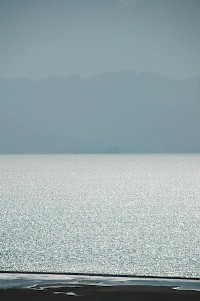
Thospitis, a large, triangular-shaped lake in ancient Armenia, is mentioned in several ancient sources. For example, the geographer Strabo knows that it is very large and has briny water.note This is correct. With a surface of 3,713 square kilometers, and a width of almost 120 kilometer, it is the largest lake of Turkey. The water is indeed salty, and Strabo is right when he says that it is unfit for drinking,note a remark he attributes to Eratosthenes. Strabo is also right when he says that there is only one kind of fish that can live in Lake Thospitis, which ichthyologists say is a small type of mackarel.
On the other hand, the ancients were certainly wrong when they said that the river Tigris passed through Thospitis, flowing to its real source through an underground connection.note Although this tunnel does not exist, the theory is less crazy than it sounds: the ancients were aware that the lake had no outlet. In fact, the waters evaporate, leaving behind the minerals they have carried with them. This explains how Thospitis became the largest soda lake in the world.
The discharge of the inflowing rivers is in balance with the evaporation, and the level of the lake is fluctuating with the temperature: in the winter, it is higher than in the summer. If it is really cold, nothing changes, because the northern part freezes over. (The southern part is not sufficiently shallow, and besides, the water is salty.) The level is highest in the spring, after the snow has melted.
The reason why the lake, which is essentially the normal valley of the rivers Zilan and Bendimahi flowing down from the north, has no outlet, is that a volcano in the southwest of the lake, Mount Nemrud (not to be confused with the more famous mountain with the same name), once erupted a large lava flow, which has become a natural barrier. To the northwest, another volcano, Süphan, blocks a possible exit.
Strabo also comments that the waters of Thospitis were used to do the laundry. Incidentally, the first reference to the lake also refers to the possibility to wash objects: one of the inscriptions on the Balawat Gate from the Assyrian capital Kalhu (Nimrud), now in the British Museum, tells that king Šalmaneser III (r. 859-824) "descended to the sea of Urartu and washed [his] terrible weapons in its waters".
The lake belongs to the heartland of the ancient Iron Age kingdom Urartu. To the east of the lake was the residence of its kings, Tušpa, on a steep hill. "Thospitis" is of course a rendering of the name of this site. It is likely that that the palace was still in use in Achaemenid times, because there is a royal inscription by Xerxes on the southern slope of the hill.
More recent is the Armenian church of the Twelve Apostles on Akdamar Island, with a fine decoration that includes a drunken Noah. It reminds one of the fact that eastern Christians have always believed that after the Great Flood, the Ark landed somewhere south of Thospitis, in the Antitaurus. (It was much later that the Ağrı Dağı was identified with the so-called "Mount Ararat".)
Finally, it must be noted that to the northwest of the lake is Manzikert, where the Byzantine emperor Romanus IV Diogenes was in 1071 defeated by the Seljuk sultan Alp Arslan: the beginning of the end of the Byzantine Empire.
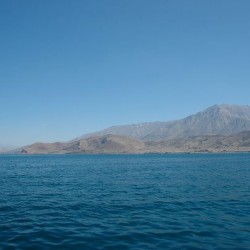 Lake Van from the southwest |
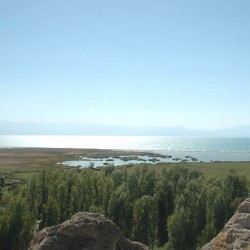 Lake Van from Van |
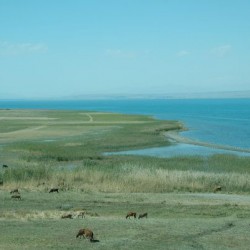 Lake van from the northeast |
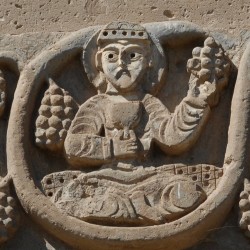 Akdamar, Relief of a drunken Noah |